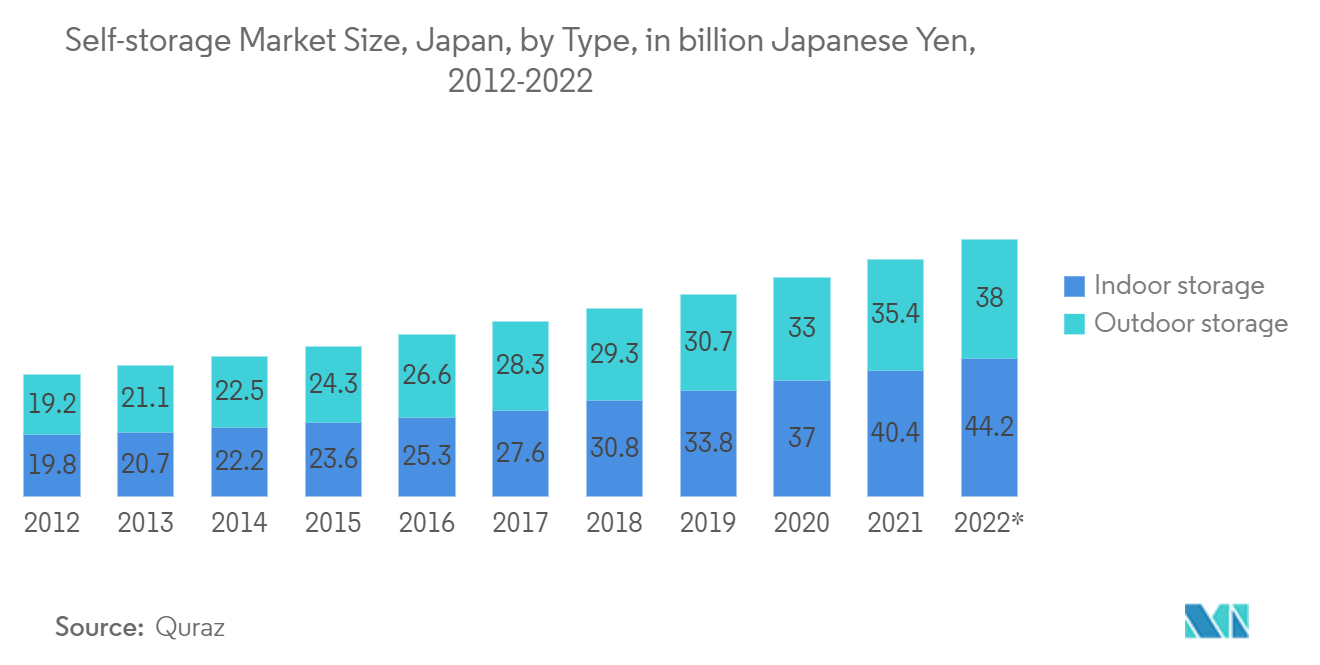Market Trends of Asia-Pacific Self Storage Industry
Rising Consumerism and Population Density is Driving the Market Growth
- Self-storage facilities are expanding steadily in the region, despite many businesses struggling during difficult economic times. Demand for self-storage is surging as a culture of consumerism, the expansion of e-commerce, the constricting availability of living space, and the growing population drive demand from individuals and families for safe and efficient facilities for storing personal items.
- Growing urbanization is one of the significant factors positively driving market growth. Growing urban populations result in more tenants who move around frequently and smaller, more expensive living areas in cities. Self-storage businesses have established themselves in Asia's more populous and affluent regional cities. Affluent neighborhoods tend to have a greater propensity for inhabitants to buy luxuries that take up more room in their homes. There is an increasing demand for specialized storage options, such as climate-controlled storage containers, to preserve expensive goods such as wine, antique furniture, or electronics.
- In the region, the smallest average dwelling sizes are found in Singapore, Hong Kong, and Tokyo. Singapore has a dense population and the smallest dwelling sizes in Asia, with an average of 730 square feet. More than 75% of residential units lack a storage area. According to information from the Urban Redevelopment Authority (URA), housing prices have increased in Singapore over the last five years. Furthermore, the growing population density in countries such as China and India contributes to the market growth rate during the forecast period. Self-storage companies have expanded all over Asia, remodeling aging facilities and preparing brand-new construction. Additionally, to meet the market's shifting demands, the nation is expected to experience an increase in demand for long-term storage users, resulting in notable expansions in the region.

Japan to have the Largest Lettable Area in the Asia Pacific Region
- In Japan, the self-storage market has gradually gained recognition among consumers and as a new real estate investment product, leading to market expansion in the past few years. Decentralizing the housing of furniture and valuables, stockpiling survival food for emergency and natural disasters such as earthquakes, and attention to the industry have intensified with self-storage.
- There are three self-storage business classifications in Japan: trunk room, rental-storage space, and rental container. First is the so-called "trunk room" managed under the Warehousing Business Act. These operators must repay customers for the stored property. Next, is a class called a "rental-storage space" that uses rooms set up in a building or specialized facility for leasing. The last class is called a "rental container," mainly set up outdoors for rental.
- Furthermore, the warehousing industry, which focused only on a business-to-business format, has expanded its business to the trunk-room business to target the general consumer as a new business type. Additionally, trunk room self-storage facilities are gaining significant traction, with the leading market vendors in the country offering innovative solutions. Self-storage facilities are called "trunk rooms" in Japan.
- For instance, according to the latest estimates based on the Annual Supply Survey conducted in November 2021 by Quraz, the storage room market (including indoor and outdoor) has expanded significantly to JPY 67 billion, doubling over the past ten years. Furthermore, according to the survey, new storage needs have arisen due to changes in the living environment, such as the rapid penetration of telework and online learning and the ongoing stay-at-home lifestyle.


